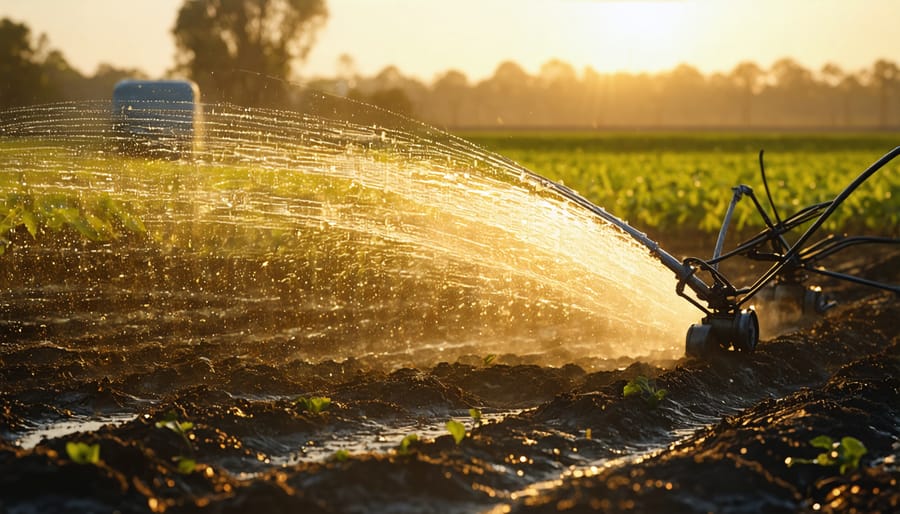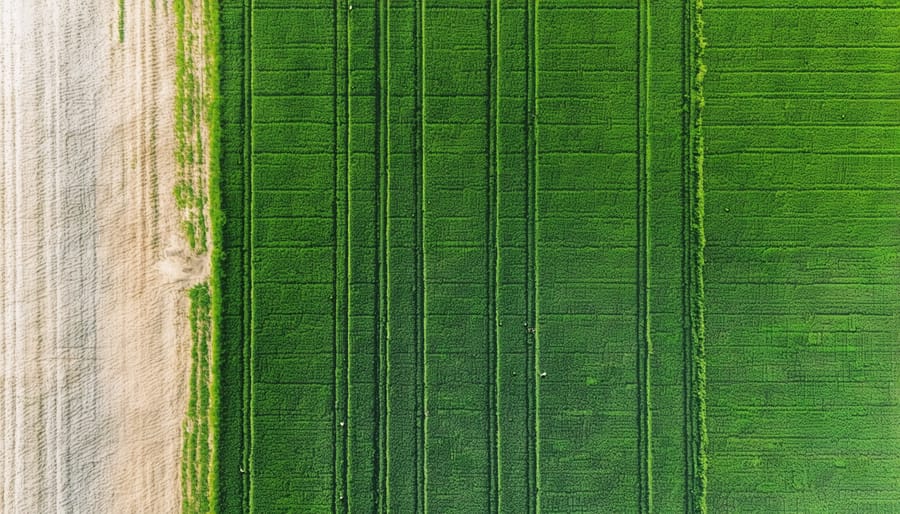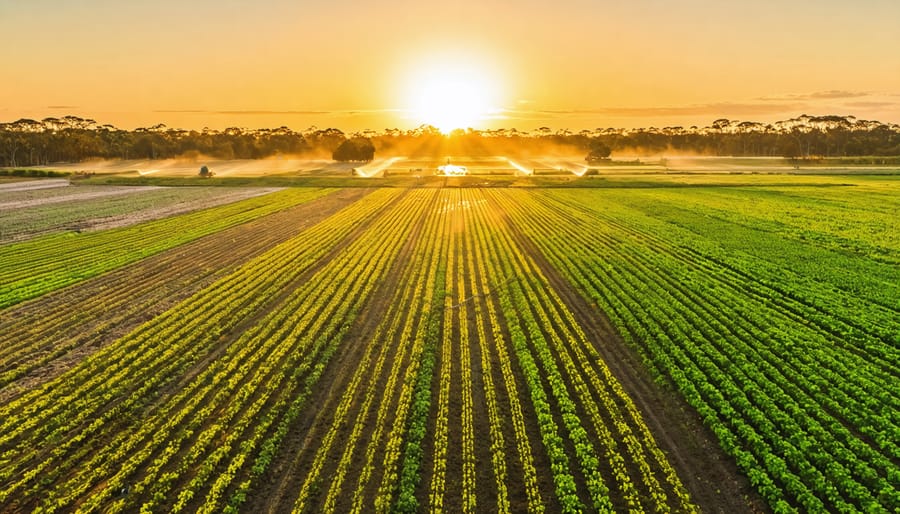Transform your farm into a beacon of sustainability through seven groundbreaking agricultural practices that revolutionize food production while supporting bioenergy production. From Australia’s sun-scorched outback to its fertile coastlines, farmers are pioneering methods that slash water consumption by 40%, regenerate soil health, and boost crop yields while reducing chemical inputs.
These time-tested practices don’t just preserve our land—they enhance it. By integrating traditional knowledge with cutting-edge innovation, modern sustainable agriculture creates resilient farming systems that withstand climate challenges while generating consistent profits. Whether you’re managing a large-scale operation or a small family farm, these seven practices offer practical solutions that protect our environment, strengthen food security, and build a legacy of responsible land stewardship for future generations.
As extreme weather events become more frequent and resource pressures mount, mastering these sustainable techniques isn’t just an option—it’s essential for survival and success in modern agriculture. Let’s explore how these proven methods can transform your farming operation while contributing to Australia’s sustainable future.
Conservation Tillage: Protecting Soil While Saving Energy

Implementing No-Till Farming
Transitioning to no-till farming represents a game-changing shift in Australian agriculture, offering significant benefits for both soil health and bioenergy crop production. To implement this practice, farmers first need to invest in specialized equipment, particularly direct-seed drills that can plant through crop residue. The transition typically begins with a cover crop phase, which helps build soil structure and organic matter.
Success stories from the Western Australian wheatbelt show that farmers who’ve made the switch are seeing up to 40% reduction in fuel costs and significant improvements in soil moisture retention. The practice involves leaving crop residue on the field after harvest, creating a protective layer that prevents erosion and builds organic matter.
For bioenergy crop production, no-till practices create an ideal environment for crops like canola and sorghum, which can later be used for biofuel production. The increased soil organic matter also helps sequester carbon, creating a double benefit for climate action.
Key steps include soil testing before transition, selecting appropriate cover crops for your region, and maintaining careful weed management during the first two seasons. Many farmers find that after three years, the soil structure improves dramatically, leading to better water infiltration and reduced input costs.
Crop Rotation and Diversity
Bioenergy Crops in Rotation
Integrating bioenergy crops into traditional farming rotations represents a game-changing approach that aligns perfectly with circular economy principles. Australian farmers are increasingly incorporating crops like oil mallee, sorghum, and short-rotation coppice into their existing agricultural systems, creating dual-purpose farmland that produces both food and energy.
This smart rotation strategy offers multiple benefits: it helps prevent soil erosion, improves soil fertility, and provides additional income streams for farmers. During off-seasons for traditional crops, these energy-producing plants continue working the soil, maintaining its structure and adding valuable organic matter.
In regions like Western Australia’s wheatbelt, farmers have successfully integrated oil mallee alongside their wheat crops, creating natural windbreaks while harvesting the trees periodically for bioenergy production. This approach has shown remarkable success in areas prone to salinity, where deep-rooted energy crops help manage water tables while producing valuable biomass.
The beauty of this system lies in its flexibility – farmers can adjust their rotation patterns based on market demands and seasonal conditions, ensuring both food security and sustainable energy production.
Water Management Excellence

Drought-Resistant Practices
In the face of Australia’s increasingly unpredictable climate, implementing drought-resistant practices has become essential for sustainable agriculture. Leading farmers are adopting deep-rooting crop varieties that can access moisture stored deep in the soil profile. Mulching and conservation tillage help retain precious soil moisture, while drought-tolerant native species create effective windbreaks that reduce evaporation rates.
Smart irrigation systems equipped with soil moisture sensors ensure water is applied only when and where needed, maximising efficiency. Many farmers are also establishing swales and catchment areas to harvest rainwater during wet seasons, creating reserves for drier periods. The integration of drought-hardy legumes into crop rotations improves soil structure and water retention while providing valuable nitrogen fixation benefits.
These adaptive strategies not only protect against drought but also build long-term farm resilience while maintaining productivity in challenging conditions.
Integrated Pest Management
Integrated Pest Management (IPM) stands as a cornerstone of sustainable agriculture, offering farmers a smart, nature-based approach to pest control that reduces reliance on chemical pesticides. This holistic strategy combines biological control, habitat manipulation, and resistant plant varieties to keep pest populations at manageable levels while protecting beneficial insects and wildlife.
Australian farmers are increasingly adopting IPM techniques such as companion planting, where crops like marigolds and lavender naturally repel harmful insects while attracting beneficial ones. The introduction of natural predators, such as ladybirds to control aphids or parasitic wasps to manage caterpillars, has proven particularly effective in many regions across the country.
Regular monitoring and early detection form the backbone of successful IPM programs. Farmers use pest traps and conduct weekly crop inspections to identify potential issues before they become serious problems. This proactive approach allows for targeted interventions using the least harmful methods first.
Cultural practices like crop rotation and maintaining healthy soil help build natural resistance to pests. Many successful Australian farms have established beetle banks and insectary strips – areas of native vegetation that provide habitat for beneficial insects and natural pest predators.
When chemical interventions are necessary, IPM practitioners choose selective pesticides that target specific pests while minimising impact on beneficial organisms. This strategic approach not only protects farm ecosystems but also helps prevent the development of pesticide resistance.
Agroforestry Integration
Agroforestry integration represents one of Australia’s most promising sustainable agriculture practices, combining traditional farming with strategic tree cultivation to create resilient and productive landscapes. This approach involves deliberately incorporating trees and shrubs into crop and animal farming systems, creating a symbiotic relationship that benefits both the environment and farm productivity.
In the Australian context, farmers are increasingly adopting silvopastoral systems, where trees provide shade for livestock while contributing to soil health and biodiversity. Popular combinations include eucalyptus or acacia species with grazing pastures, or fruit trees integrated with vegetable crops. These systems not only enhance farm resilience but also create additional income streams through timber, fruit, or nut production.
The benefits of agroforestry extend well beyond the immediate farm environment. Trees act as natural windbreaks, reducing soil erosion and protecting crops from harsh weather conditions. Their deep root systems improve soil structure and water retention, while fallen leaves contribute to organic matter content. Additionally, these systems serve as valuable carbon sinks, helping farms contribute to climate change mitigation.
Success stories across Queensland and Victoria demonstrate how agroforestry can increase overall farm productivity by up to 40% compared to conventional monoculture systems. Many farmers report improved soil health, reduced fertiliser requirements, and enhanced biodiversity, with native birds and beneficial insects returning to their properties. This practice exemplifies how traditional farming wisdom combined with modern agricultural science can create sustainable, productive farming systems for Australia’s future.
Organic Soil Amendments
Enriching soil naturally is at the heart of sustainable farming, and organic amendments offer a powerful solution that benefits both the land and crop yields. By incorporating compost, green manure, and animal waste, farmers create nutrient-rich environments that support healthy plant growth while reducing dependency on synthetic fertilisers.
Australian farmers are increasingly turning to locally-sourced organic materials like sheep manure, crop residues, and kitchen waste to create high-quality compost. This practice not only diverts waste from landfills but also builds soil structure and increases water retention capacity – crucial for our drought-prone climate.
Cover crops, particularly legumes like clover and lucerne, serve as excellent green manure when ploughed back into the soil. These plants naturally fix nitrogen and add organic matter, improving soil fertility while protecting against erosion during fallow periods.
Worm farming and bio-fertilisers are gaining popularity, with many farmers establishing their own vermiculture systems to produce nutrient-rich castings. These natural amendments enhance soil biology, promoting beneficial microorganisms that support plant health and resilience against pests and diseases.
Precision Agriculture Technology
Modern farming has embraced digital innovation to maximise efficiency and reduce environmental impact. GPS-guided tractors, drone technology, and smart sensors are revolutionising how Australian farmers manage their land. These precision tools enable targeted application of water, fertilisers, and pesticides, dramatically reducing waste while optimising crop yields.
Soil moisture sensors and weather stations provide real-time data, allowing farmers to make informed decisions about irrigation timing and volume. Advanced mapping technologies create detailed soil composition analyses, enabling variable-rate application of inputs across different field zones. This technology-driven approach has become increasingly attractive for sustainable agricultural investments, particularly in drought-prone regions.
Australian farmers are also adopting machine learning algorithms that predict pest outbreaks and disease spread, allowing for preventive rather than reactive measures. Mobile apps now help track crop health, livestock movement, and equipment maintenance, streamlining farm operations while reducing resource consumption. These smart farming practices not only boost productivity but also contribute significantly to environmental conservation by minimising the use of water, chemicals, and fuel.

The integration of these seven sustainable agriculture practices represents a powerful pathway toward a more resilient and environmentally conscious farming future in Australia. By combining these methods, farmers can significantly reduce their environmental impact while maintaining or even improving productivity. These practices work synergistically to create a closed-loop system that not only supports sustainable food production but also contributes to Australia’s renewable energy transformation. The potential for generating bioenergy from agricultural waste, while simultaneously improving soil health and water efficiency, demonstrates how modern farming can be both profitable and environmentally responsible. As more Australian farmers adopt these practices, we’re building a stronger, more sustainable agricultural sector that benefits both current and future generations. The success stories emerging across the country prove that sustainable agriculture isn’t just an idealistic goal – it’s a practical reality that’s already transforming our farming landscape.

